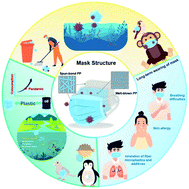A pandemic-induced environmental dilemma of disposable masks: solutions from the perspective of the life cycle†
Abstract
The coronavirus disease 2019 (COVID-19) has swept the world and still afflicts humans. As an effective means of protection, wearing masks has been widely adopted by the general public. The massive use of disposable masks has raised some emerging environmental and bio-safety concerns: improper handling of used masks may transfer the attached pathogens to environmental media; disposable masks mainly consist of polypropylene (PP) fibers which may aggravate the global plastic pollution; and the risks of long-term wearing of masks are elusive. To maximize the utilization and minimize the risks, efforts have been made to improve the performance of masks (e.g., antivirus properties and filtration efficiency), extend their functions (e.g., respiration monitoring and acting as a sampling device), develop new disinfection methods, and recycle masks. Despite that, from the perspective of the life cycle (from production, usage, and discard to disposal), comprehensive solutions are urgently needed to solve the environmental dilemma of disposable masks in both technologies (e.g., efficient use of raw materials, prolonging the service life, and enabling biodegradation) and policies (e.g., stricter industry criteria and garbage sorting).

- This article is part of the themed collections: Environmental exposure and impacts, World Earth Day and SDG14: Life Below Water – Marine Litter (Plastics and Pollution)


 Please wait while we load your content...
Please wait while we load your content...